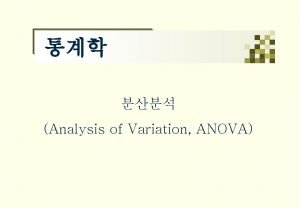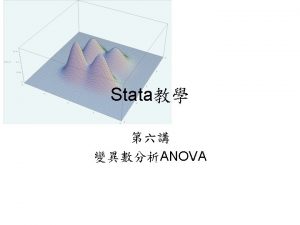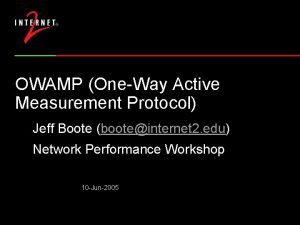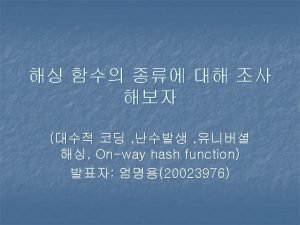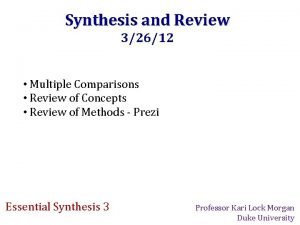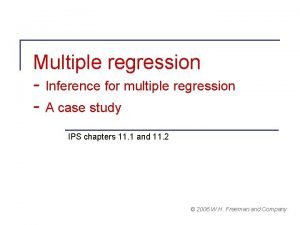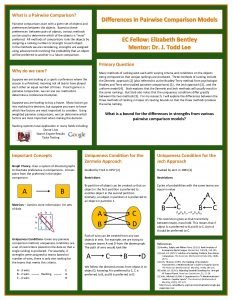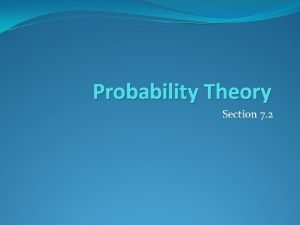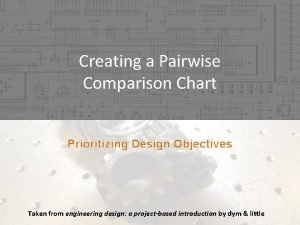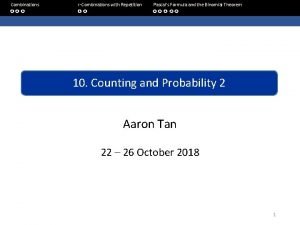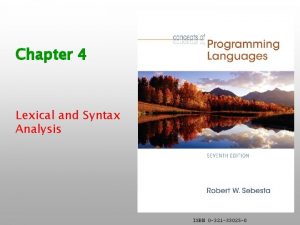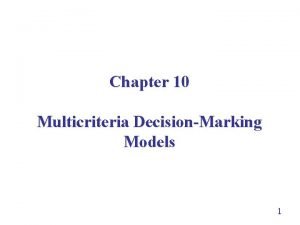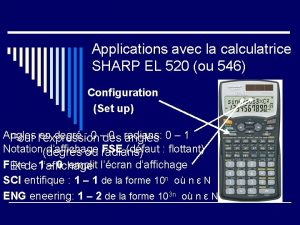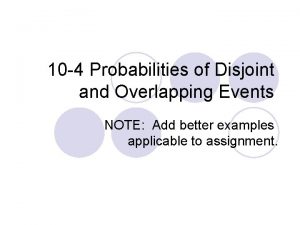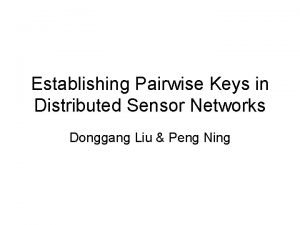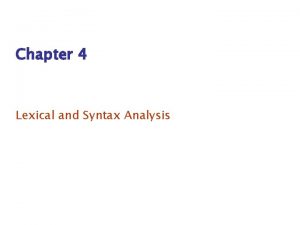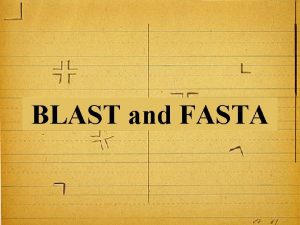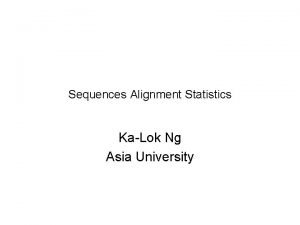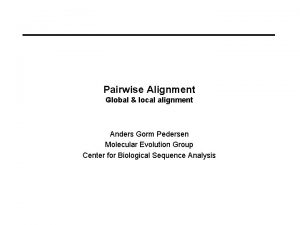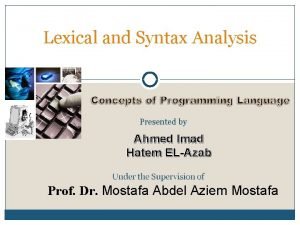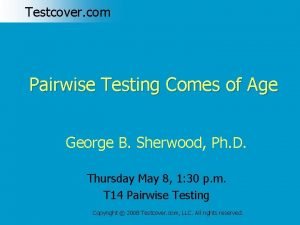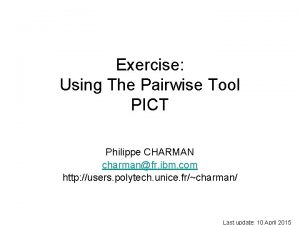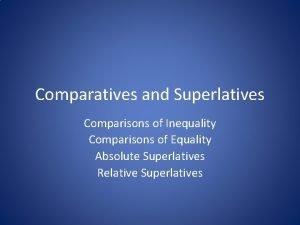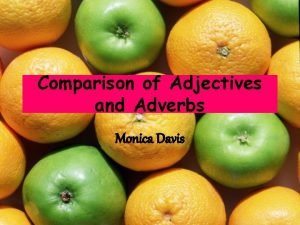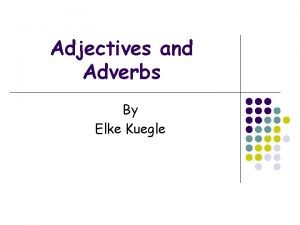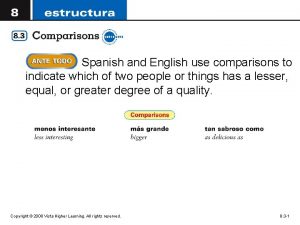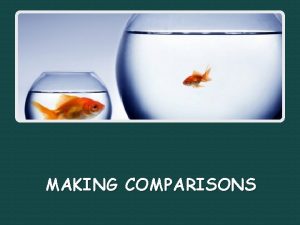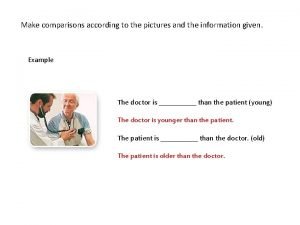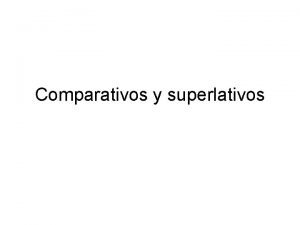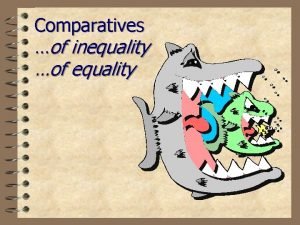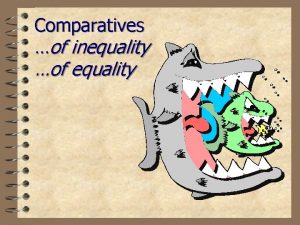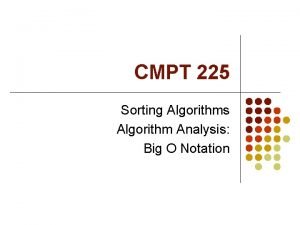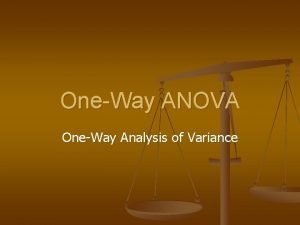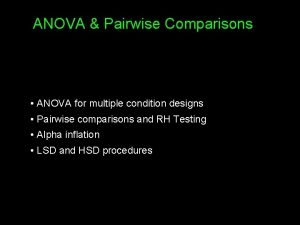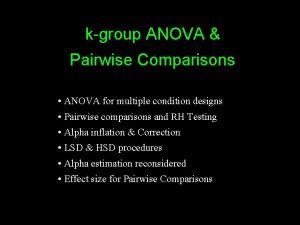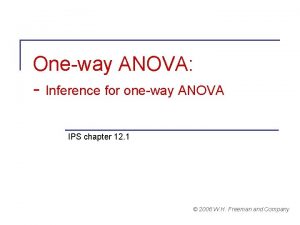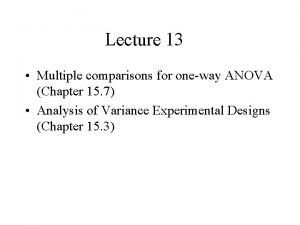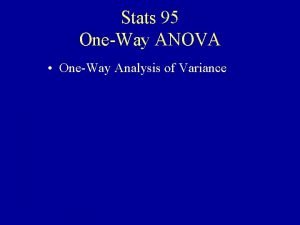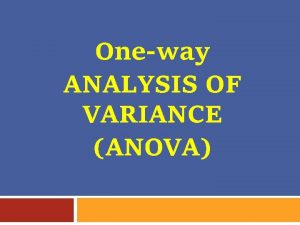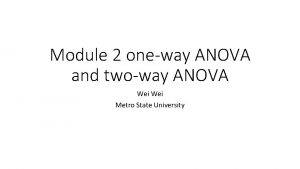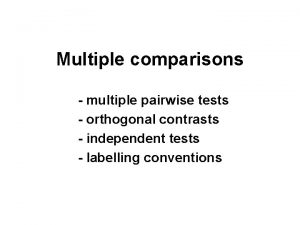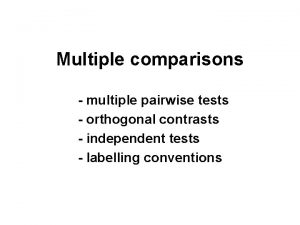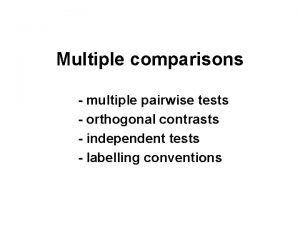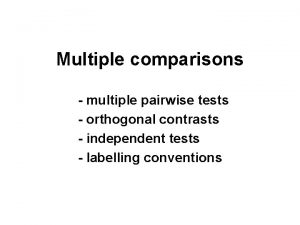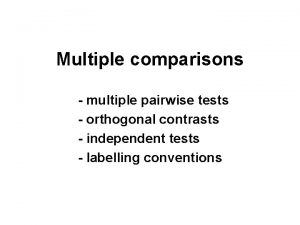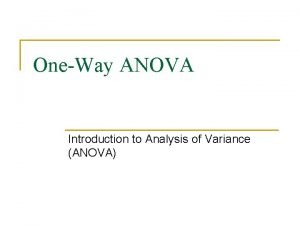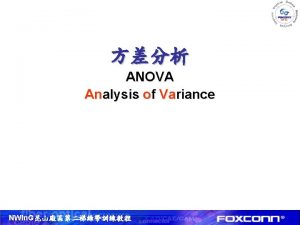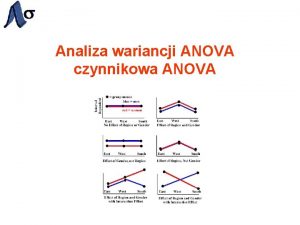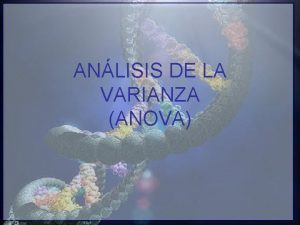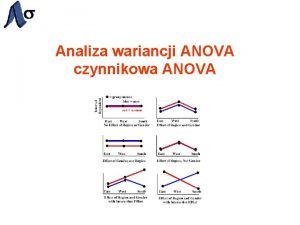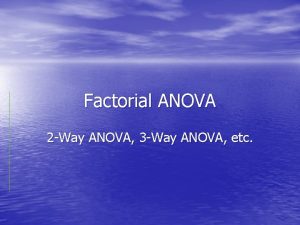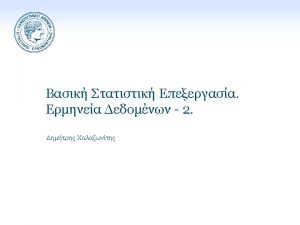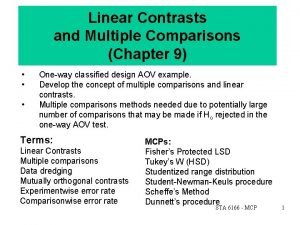OneWay ANOVA Multiple Comparisons Pairwise Comparisons and Familywise













































- Slides: 45

One-Way ANOVA Multiple Comparisons

Pairwise Comparisons and Familywise Error • fw is the alpha familywise, the conditional probability of making one or more Type I errors in a family of c comparisons. • pc is the alpha per comparison, the criterion used on each individual comparison. • Bonferroni: fw c pc

Multiple t tests • We could just compare each group mean with each other group mean. • For our 4 -group ANOVA (Methods A, B, C, and D) that gives c = 6 comparisons • AB, AC, AD, BC, BD, and CD. • Suppose that we decided to use the. 01 criterion of significance for each comparison.

c = 6, pc =. 01 • alpha familywise might be as high as 6(. 01) =. 06. • What can we do to lower familywise error?

Fisher’s Procedure • Also called the “Protected Test” or “Fisher’s LSD. ” • Do ANOVA first. • If ANOVA not significant, stop. • If ANOVA is significant, make pairwise comparisons with t. • For k = 3, this will hold familywise error at the nominal level, but not with k > 3.

Computing t • Assuming homogeneity of variance, use the pooled error term from the ANOVA: • For A versus D:

• For A versus C and B versus D: • For B versus C • For A vs B, and C vs D,

Underlining Means Display • arrange the means in ascending order • any two means underlined by the same line are not significantly different from one another Group A B C D Mean 2 3 7 8

Linear Contrasts • • • One coefficient for each group mean Sum to zero One set negative, one positive Groups A B C D E -3 -3 2 2 2 compares (AB) with (CDE) 0 0 -2 1 1 compares C with (DE)

Standard Contrast Coefficients • • • n = number of means in set Coefficients -1/n 1 and 1/n 2 Sum = 0 Sum of absolute values = 2 -1/2 1/3 1/3 codes (AB) vs. (CDE) 0 0 -1 1/2 codes C vs. (DE)

Calculate a Contrast & SS Unequal Sample Sizes Equal Sample Sizes

Methods AB vs. CD (Teach ANOVA Data) • The means are (2, 3) vs. (7, 8) – ie, 2. 5 vs. 7. 5, a difference of 5. • The coefficients are -. 5, . 5 F(1, 16) = 125/. 5 = 250, p <<. 01

Standard Error & CI for Psi Unequal Sample Sizes Equal Sample Sizes • For a CI, go out in each direction • 95% CI is 5 2. 12(. 3162), 4. 33 to 5. 67.

Standardized Contrasts • How different are the two sets of means in standard deviation units? • For our contrast,

Standardized Contrast from F • SAS will give you the F for a contrast.

Approximate CI for Contrast d • Simply take the unstandardized CI and divide each end by s. • Our unstandardized CI was 4. 33 to 5. 67 • Divide each end by s =. 707. • Standardized CI is 6. 12 to 8. 02

Exact CI for Contrast d • Conf_Interval-Contrast. sas • The CI extends from 4. 48 to 9. 64 • Notice that this is considerably wider than the approximate CI • The program is a pain in the arse to use. • If you have more than three groups, you will need to modify the code.

Replace tttt with the computed value of the contrast t. Replace dd with the degrees of freedom for the error term. Replace n 1 n with the sample size for the first group. Replace n 2 n with the sample size for the second group. Replace n 3 n with the sample size for the third group. Replace c 1 c, c 2 c, and c 3 c with the standard contrast coefficients for the desired contrast; t= 15. 811 ; {the t here is the square root of the Contrast F} df = 16 ; n 1 = 5 ; n 2 = 5 ; n 3 = 5 ; n 4 = 5 ; c 1 = -. 5 ; c 2 = -. 5 ; c 3 =. 5 ; c 4 =. 5 ;

ncp_lower = TNONCT(t, df, . 975); ncp_upper = TNONCT(t, df, . 025); d_lower = ncp_lower*sqrt(c 1*c 1/n 1 + c 2*c 2/n 2 + c 3*c 3/n 3 + c 4*C 4/n 4); d_upper = ncp_upper*sqrt(c 1*c 1/n 1 + c 2*c 2/n 2 + c 3*c 3/n 3 + c 4*C 4/n 4); output; run; proc print; var d_lower d_upper; run; In red is the modification needed if you have four instead of three groups d_lower 4. 47861 d_upper 9. 63634

2 for Contrast AB vs CD • 2 = SScontrast/SStotal 125/138 =. 9058 • partial 2 : • Notice that this excludes from the denominator that part of the SSAmong that is not captured by the contrast

SS for Contrast A vs B & C vs D • SStotal = SSAB-CD + SS A-B + SSC-D + SSerror = 125 + 2. 5 + 8 = 138 We have divided the total SS into four orthogonal pieces.

2 for All Three Contrasts • AB vs CD: 2 = SScontrast/SStotal 125/138 =. 9058 • A vs B: 2. 5/138 =. 018 • C vs D: 2. 5/138 =. 018 • Sum these three and get. 942, which is the eta squared we got for the overall ANOVA effect of type of instruction.

Partial 2 for All Three Contrasts • AB vs CD: • A vs B: 2. 5/(2. 5 + 8) =. 2381 • C vs D: 2. 5/(2. 5 + 8) =. 2381 • Sum these and get 1. 416. Wow, we have explained 142% of the variance in quiz scores.

CI for Contrast 2 AB vs CD • Conf-Interval-R 2 -Regr. sas • For partial 2 enter the contrast F (1, 16) = 250. The CI is [. 85, . 96]. • For 2 enter an adjusted F that adds to the denominator all SS and df not captured by the contrast: • F(1, 18) = 173. 077; The CI is [. 78, . 94].

SAS to the Rescue SAS will give you semipartial and partial etasquared with confidence intervals. SPSS will give you only partial eta-squared and no confidence intervals Contrast DF Contrast Total Variation Accounted For SS Semipar Conservative tial Etatial 90% Confidence Square Omega. Limits Square Partial Variation Accounted For Partial 90% Confidence Eta- Omega. Limits Square Placebo vs Drug 1 1831. 84 0. 1259 0. 1196 0. 0401 0. 2290 0. 1909 0. 1764 0. 0818 0. 2946 Lo vs Hi 1 3948. 05 0. 2713 0. 2642 0. 1521 0. 3793 0. 3371 0. 3212 0. 2060 0. 4351 10 vs 20 1 156. 025 0. 0107 0. 0051 0. 0000 0. 0668 0. 0197 0. 0090 0. 0000 0. 0842 30 vs 40 1 855. 625 0. 0588 0. 0529 0. 0062 0. 1462 0. 0993 0. 0865 0. 0231 0. 1947

Orthogonal Contrasts • Can obtain k-1 of these • Each is independent of the others • It must be true that • With equal sample sizes,

A +. 5 +1 0 B +. 5 1 0 C 1/3 0 1 D 1/3 0 . 5 E 1/3 0 . 5 0 0 0 +1 1 (. 5)(1)+(. 5)(-1)+(-1/3)(0)+(-1/3)(0) = 0 You verify that the cross products sum to zero for all other pairs of rows. If you calculated SScontrast for each of these four contrasts, they would sum to be exactly equal to the SSAmong

Procedures Designed to Cap FW • We have already discussed Fisher’s Procedure, which does require that the ANOVA be significant. • None of the other procedures require that the ANOVA be significant. • They were designed to replace the ANOVA, not be done after an ANOVA.

A Common Delusion • Many mistakenly believe that all procedures require a significant ANOVA. • This is like being so paranoid about getting an STD that you abstain from sex and wear a condom. • If you have done the one, you do not also need to do the other.

Studentized Range Procedures • These are often used when one wishes to compare each group mean with each other group mean. • I prefer to make only comparisons that address a research question. • The test statistic is q. • See the handout for an example using the Student Newman Keuls procedure.

q, t, and F • If you obtain t or F, by hand or by computer, you can easily convert it into q

Tukey’s (a) Honestly Significant Difference Test • If part of the null is true and part false, the SNK can allow to exceed its nominal level. • Tukey’s HSD is more conservative, and does not allow to exceed its nominal level.

Tukey’s (b) Wholly Significant Difference Test • SNK too liberal, HSD too conservative, OK let us compromise. • For the WSD the critical value of q is the simple mean of what it would be for the SNK and what it would be for the HSD.

Ryan-Einot-Gabriel-Welsch Test • Holds familywise error at the stated level. • Has more power than other techniques which also adequately control familywise error. • SAS and SPSS will do it for you. • It is much too difficult to do by hand.

Which Test Should I Use? • If k = 3, use Fisher’s Procedure • If k > 3, use REGWQ • Remember, ANOVA does not have to be significant to use REGWQ or any of the procedures covered here other than Fisher’s procedure.

The Bonferroni Procedure • Compute an adjusted criterion of significance to keep familywise error at desired level • Although conservative, this procedure may be useful when you are making a few focused comparisons. Also known as the Dunn Test.

• For our data, • Compare each p with the adjusted criterion. • For these data, we get same results as with Fisher’s procedure. • In general, this procedure is very conservative (robs us of power).

αFW with Orthogonal Contrasts For each contrast, pc = Pcond(Type I Error) and (1 - pc) = Pcond(Not Type I Error) With c independent contrasts, (1 - pc)c = Pcond(No Type I Errors in c comparisons) • 1 - (1 - pc)c = Familywise alpha • For our example and three orthogonal contrasts, • •

Dunn-Sidak Procedure When the contrasts are NOT orthogonal, • Accordingly, we can adjust the alpha this way: Reject the null only if • Slightly less conservative than the Bonferroni.

Scheffé Test • Assumes you make every possible contrast, not just each mean with each other. • Very conservative. • adjusted critical F equals (the critical value for the treatment effect from the omnibus ANOVA) times (the treatment degrees of freedom from the omnibus ANOVA).

Dunnett’s Test • Used only when you are comparing each treatment group with a single control group. • Compute t as with the Bonferroni or LSD test. • Then use a special table of critical values.

Presenting the Results Teaching method significantly affected test scores, F(3, 16) = 86. 66, MSE = 0. 50, p <. 001, η 2 =. 94, 95% CI [. 82, . 94]. Pairwise comparisons were made with Tukey’s HSD procedure, holding familywise error at a maximum of. 01. As shown in Table 1, the computer intensive and discussion centered methods were associated with significantly better student performance than that shown by students taught with the actuarial and book only methods. All other comparisons fell short of statistical significance.

Table 1 Mean Quiz Performance By Students Taught With Different Methods Method of Instruction Actuarial Book Only Computer Intensive Mean 2. 00 A 3. 00 A 7. 00 B Discussion Centered 8. 00 B Note. Means sharing a letter in their superscript are not significantly different at the. 01 level according to a Tukey HSD test.

Familywise Error and the Boogey Man • Please read my rant at http: //core. ecu. edu/psyc/wuenschk/docs 30 /Familywise. Alpha. htm • These procedures may cause more harm that good. • They greatly sacrifice power, making Type II errors much more likely.

 Pairwise comparison anova
Pairwise comparison anova Stata oneway
Stata oneway Owping
Owping Oneway hash
Oneway hash Beda one way anova dan two way anova
Beda one way anova dan two way anova One way anova vs two way anova
One way anova vs two way anova Analisis two way anova
Analisis two way anova Xkcd 882
Xkcd 882 Anova multiple regression
Anova multiple regression Pairwise comparison
Pairwise comparison Pairwise independent
Pairwise independent Greedy algorithm
Greedy algorithm Comparison chart design
Comparison chart design Pairwise independent
Pairwise independent Types of corelation
Types of corelation Pairwise disjointness test
Pairwise disjointness test Pairwise comparison matrix
Pairwise comparison matrix Sharp el-546x
Sharp el-546x Probability of disjoint events
Probability of disjoint events Pairwise key
Pairwise key Lexical and syntax analysis
Lexical and syntax analysis Blast global alignment
Blast global alignment Ebi pairwise alignment
Ebi pairwise alignment Pairwise alignment
Pairwise alignment Pairwise alignment
Pairwise alignment Pairwise alignment
Pairwise alignment Listwise vs pairwise
Listwise vs pairwise Pairwise disjointness test
Pairwise disjointness test Everyday is a new beginning
Everyday is a new beginning Pairwise.org
Pairwise.org Pict tool
Pict tool Multiple baseline vs multiple probe design
Multiple baseline vs multiple probe design Shared memory mimd architecture
Shared memory mimd architecture A priori and post hoc comparisons
A priori and post hoc comparisons Comparison of inequality examples
Comparison of inequality examples Adverbs of the adjectives
Adverbs of the adjectives Comparisons of adjectives and adverbs
Comparisons of adjectives and adverbs Anova within group and between group
Anova within group and between group Ernesto mira mas television que alberto
Ernesto mira mas television que alberto Figures of speech examples
Figures of speech examples Bad的superlative
Bad的superlative Images to make comparisons
Images to make comparisons Comparisons ejemplos
Comparisons ejemplos Comparative of equality and inequality
Comparative of equality and inequality Comparatives of equality and inequality ejemplos
Comparatives of equality and inequality ejemplos Cmpt 225
Cmpt 225
